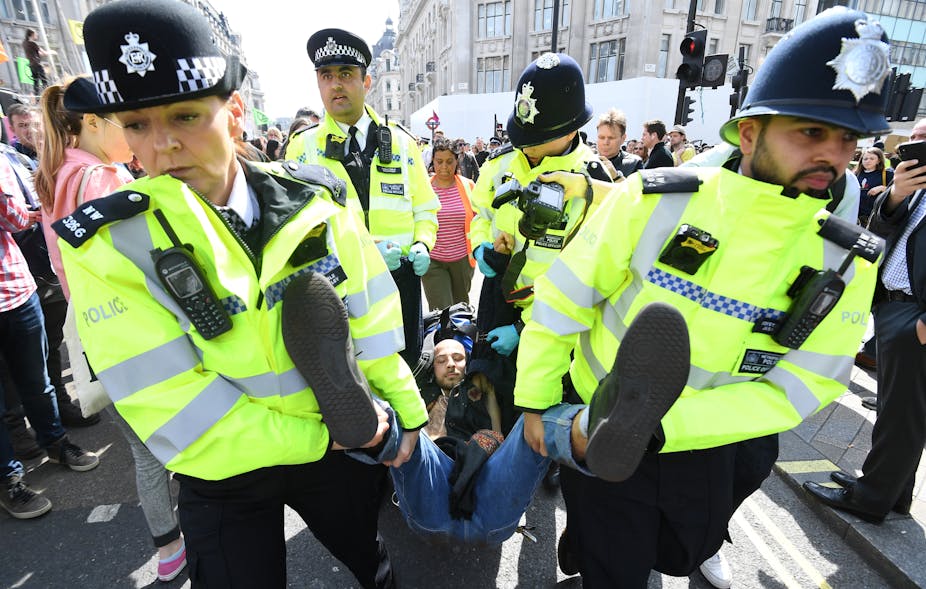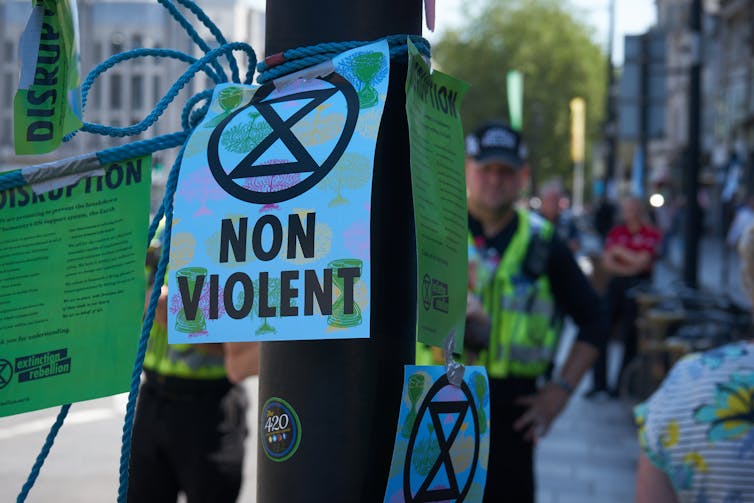 |
| XR protesters getting carried away. Image credit: Facundo Arrizabalaga/EPA. |
After occupying parts of central London over two weeks in April, Extinction Rebellion’s (XR) summer uprising has now spread to Cardiff, Glasgow, Leeds and Bristol. All these protests involve disruption, breaking the law and activists seeking arrest.
Emotions are running high, with many objecting to the disruption. At the same time, the protests have got people and the media talking about climate change. XR clearly represents something new and unusual, which has the power to annoy or enthuse people. But what led it to adopt such disruptive tactics in its efforts to demand action on climate change?
XR is accused of being an anarchist group in a report from the right-wing think-tank Policy Exchange. To actual anarchists, that is laughable. XR strictly adheres to non-violence, seeks arrests and chants “we love you” to the police. This contrasts starkly with anarchists’ antagonistic relationship to the state and its law enforcement.
The movement claims to practice civil disobedience – but that is also a confusing label. Civil disobedience developed during the 20th century as a way of understanding and justifying law-breaking protests in liberal democracies. Much of this was in relation to the US civil rights movement. Liberal political thinkers like Hannah Arendt and John Rawls explored when and how disobedience was legitimate in a democracy.
The misfit rebellion
In some ways, XR fits with liberal civil disobedience. That disobedience should always be a last resort chimes well with XR’s claim that time is running out and traditional campaigning has proven unsuccessful. The voluntary arrests resonate with the liberal onus on open and conscientious law-breaking that accepts law enforcement. |
| Non-violent protest in Cardiff, July 2019. Image credit: Neil Schofield/Flickr., CC BY-NC |
But on two other crucial points, XR breaks with the liberal civil disobedience tradition. For one thing, civil disobedience is generally aimed at showing the majority of the public that specific laws are unjust. XR does not seem to focus on this majority-building. It does not engage in discussion with climate change deniers, and its disruption antagonises people who do not share its fears and frustration with the inaction of governments.
Instead, XR’s tactic is to get a significant but still small part of the population to participate in disruption. The movement aims to get 3.5% of the population so incensed that they take to the streets. It does not aim to convince 51% that this is the right thing to do.
Liberal civil disobedience maintains an overall “fidelity to law”. In other words, it is considered okay to break certain unjust laws, as long as you respect the state’s laws generally. The aim is then to get the state to have better, more just, laws.
But for XR, the social contract has already been broken. The state has failed to take necessary action on climate change, thereby putting its citizens at risk. Disruption and law-breaking are therefore justified.
Talkin’ ‘bout a revolution
XR’s tactics are not based on how social movements have achieved policy change in liberal democracies. It is based on how dictatorships have been toppled. It draws directly on Erica Chenoweth and Maria Stephan’s book Why Civil Resistance Works, where they argue that non-violence is more effective than violence. The XR tactic is therefore based on how to achieve revolutions, not on how to get governments to respond to the will of the majority.There are reasons to be sceptical about the relevance of this research, when it comes to addressing climate change. The 3.5% figure applies to such a small number of historical cases that no conclusions can be based on it. More importantly, perhaps, in most cases of regime change, not much else changes. Most in XR see saving the world as incompatible with capitalism as a system that depends on economic growth on a finite planet. Most cases of regime change on the Chenoweth and Stephan list have not resulted in abandoning capitalism – quite the opposite.
There are, however, good reasons for why XR’s radical tactics resonate with so many. People experiencing climate change through hot summers and other extreme weather events increases the sense of urgency. More importantly, perhaps, in an era of political polarisation, more extreme action becomes more likely. The trust in the state and its politicians has eroded on both the left and right across Europe. In the UK, this has been made worse by the politics of Brexit.
Law-breaking then becomes a more likely form of protest. One of XR’s spokespeople wrote on The Conversation that “the chances of … succeeding are relatively slim”. But since many in XR foresee societal breakdown as a result of climate breakdown, the cost of getting a criminal record diminishes. And if they continue to make the protests a bit of a festival, then the chances are we’ll see more disruption from Extinction Rebellion – even if it does alienate many others.
----------------------------------
This blog is written by Cabot Institute member Oscar Berglund, Lecturer in International Public and Social Policy, University of Bristol. This article is republished from The Conversation under a Creative Commons license. Read the original article.
| Oscar Berglund |
